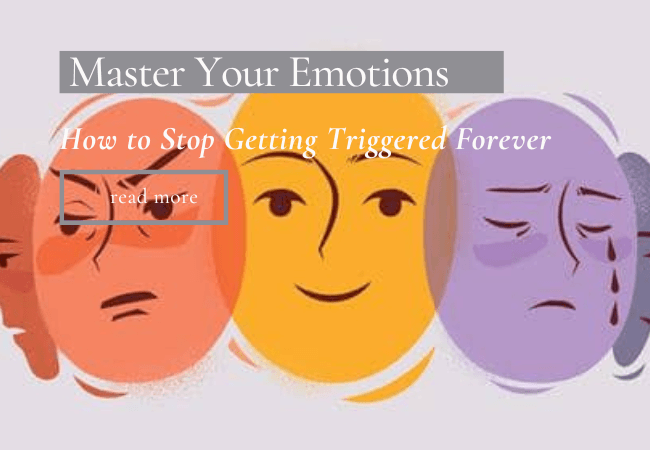
Discover the transformative journey of emotional mastery. Learn how to stop getting triggered forever and cultivate peace and empowerment.
People’s emotions controlled them, dictating their every move and decision. Everything seemed to set them off, and they felt like they were on an emotional roller coaster.
But then, they discovered the secret to emotional mastery. This is not a story but a reality that many people, including myself, live daily. Getting triggered by the most minor things in our fast-paced world is easy.
For instance, a rude comment from a colleague, missing the bus, or a slight from a friend can make us angry or sad. But what if I told you it doesn’t have to be this way? Can you learn to stop getting triggered? Can you navigate life with calm and empowerment?
This is not a quick fix or a magic pill. It’s a journey of self-discovery and personal growth. It’s about knowing your emotions, recognizing your triggers, and learning to respond, not react. It’s about taking back control of your emotional state and living a life of peace and empowerment.
So, are you ready to start this journey with me? I know I am! I hate getting triggered. I want to stop letting people, places, and things trigger me. With each step, let’s begin and remember that we’re gaining more power over our emotions.
In a world filled with emotions, there is a quest to master them. This quest is not to suppress or ignore these emotions. It is to understand, accept, and manage them. This is the journey we will take. When we dive into “Mastering Your Emotions: How to Stop Getting Triggered Forever.”
Mastering Your Emotions
The latest research and insights suggest mastering emotions requires awareness, work, and consistency. It’s not about regulating emotions but also about understanding the psyche. A new study on digital emotion contagion examines how emotions spread via digital communication. It suggests that people can manipulate moods. Also, new research looks at the link between symptoms and coping strategies.
Emotional intelligence (EQ) is a crucial predictor of mental health. In simple terms, EQ is our emotional awareness. We can regulate and express our emotions. It is also our skill in understanding and responding to others’ feelings. However, not all emotional regulation strategies are equally effective.
Research shows that managing our emotions can improve our lives. This is especially true for negative emotions like anger, fear, and sadness. Doing so can boost our mental health, careers, and relationships. It facilitates an understandable exchange of information.
Also, managing ‘strong’ emotions requires a few things. First, remove the mask around emotional ‘syndromes.’ Then, provide daily tips to manage strong feelings. Finally, note the overlap between emotional disorders and their treatments.
Mastering emotions isn’t about a destination. It’s about the journey. It’s about learning, growing, and becoming the best version of ourselves. Let’s embark on a journey together. We’ll explore our emotions and learn to master them. Remember, each step is toward a more empowered and resilient you.
How to Stop Getting Triggered Forever: A Holistic Approach
In our fast-paced world, it’s easy to overreact. Events, people, or thoughts trigger our emotions. But what if there were a way to stop being triggered forever? A transformative YouTube video inspired me. Let’s explore ways to build lasting emotional resilience.
Understanding Triggers
Triggers are emotional reactions that occur when we encounter specific stimuli. Formative events, scars, and ingrained convictions mold individual responses. When triggered, we often stop rational thinking, and our responses can be too extreme for the situation. Understanding this mechanism is the first step toward regaining control.
The Power of Awareness
The first and most crucial step in stopping triggers is awareness. Mindfulness helps us notice our thoughts and feelings as they arise. Mindfulness practices, like meditation, deep breathing, or journaling, can help. They let us observe our minds without judgment. We stop and examine when we recognize a trigger, avoiding rash actions.
Action Tip: Start daily mindfulness practice. Five minutes of morning meditation can help. It can raise your awareness of your emotional patterns.
Reframe Your Thoughts
Cognitive reframing is a powerful tool. It can change how we see and react to triggers. By challenging and reinterpreting negative thoughts, we can alter our emotional responses. If a colleague’s criticism makes you feel inadequate, try to reframe it. Instead of thinking, “I’m not good enough,” try this: “This is a chance to grow.”
Action Tip: Practice identifying and reframing one negative thought each day. Over time, this habit will help you develop a more positive and resilient mindset.
Healing Past Wounds
Our triggers often stem from past experiences that we have not resolved. Engaging in therapeutic practices can help heal these wounds. This might involve traditional therapy, like cognitive-behavioral therapy (CBT), which changes negative thought patterns. Or it could involve alternative treatments, like EMDR (Eye Movement Desensitization and Reprocessing), which helps process traumatic memories. Releasing past traumas diminishes trigger intensity and frequency.
Action Tip: Consider seeking professional support to explore and heal past traumas. Therapy can provide a ‘safe space.’ It is a confidential, non-judgmental place to process and move beyond these experiences.
Build Emotional Resilience.
To cope with life’s challenges, we must build emotional resilience. It is crucial to avoid feeling overwhelmed. This means improving your ability to manage stress and recover from tough times. Engage in regular physical activity, follow a nutritious diet, and get adequate rest. Fostering strong social connections and practicing gratitude can also enhance your emotional well-being. These strategies aim for lasting change in your emotional health. They are not just for the moment.
Action Tip: Incorporate resilience-building activities into your routine. Start with minor changes. Try a daily walk, a balanced diet, or a gratitude journal. Broaden your techniques over time.
Set Boundaries
Setting healthy boundaries is essential for protecting your emotional space. It means learning to say no. Focus on self-care. Surround yourself with supportive people. Boundaries prevent triggers and create a safe space for your growth.
Action Tip: Identify one area where you need stronger boundaries. Take a concrete step this week.
In Conclusion:
Mastering your emotions is a journey. It will help you stop getting triggered forever. It requires understanding, patience, and practice, but the rewards are immense. Imagine living a life where you are in control of your emotions, not the other way around.
To help you, I’ve written an eBook, “Be You: How to Be the Best Version of You.” It’s a guide to emotional mastery. It can help you stop getting triggered forever. You can buy it here.
Are you ready to launch on a transformative journey toward emotional mastery? Master Your Emotions is the compass you need. It’s “A Practical Guide to Overcoming Negativity and Better Managing Your Feelings.”
This book provides tactics to conquer pessimistic thinking and control emotions. It’s a guide to help you avoid triggers forever. It will lead to a more balanced, fulfilling life.
You can buy the book using an Apple device at the Apple Books store. Open the Books app, search for the title, and tap to buy. If you have an Amazon device or app, search for the book in the Amazon store and click to buy it.
Take advantage of this opportunity to gain control over your emotional landscape. Buy your copy today and start your journey toward emotional mastery. Mastering your emotions is not about feeling better. It’s about being better. Happy reading! 📚
I invite you to visit my online store at jamielondonclay.com. It has products that inspire and support your self-empowerment and growth. I will earn a commission from all purchases via the affiliate links in my blog posts and website.
Your engagement is what keeps this community thriving and growing. So, subscribe to my blog, follow me on social media, share this article with your network, and please leave a comment below. Discover your potential with Jamie London Clay’s guidance and motivation.
If you want to explore similar topics, consider subscribing to my YouTube channel. It is a community dedicated to living with more freedom and authenticity.
I am just beginning my YouTube journey, so please be patient as I roll out content there and on my blog. Let’s go on this journey of personal development together. Your trip to empowerment starts now.


I really appreciated how you broke down the steps for identifying triggers and the importance of self-awareness—it’s something I’ve been trying to work on myself. Your point about the power of mindfulness really resonated with me. Do you have any specific mindfulness exercises or techniques that you personally find most effective? Also, how long did it take for you to notice a significant change in your response to triggers? Thanks for such an insightful and practical article!
Hi Bob,
Thank you so much for your thoughtful comment! I’m thrilled to hear that the post resonated with you, mainly because of its focus on identifying triggers and the role of self-awareness. Many of us are on this journey, and I’m happy you found the insights helpful.
When it comes to mindfulness exercises, one of my go-to techniques is focused breathing. It’s simple but powerful—just taking a few minutes to focus on your breath can create a sense of calm and clarity. Another technique I find compelling is body scanning, where you mentally scan your body from head to toe, noticing any areas of tension and consciously relaxing them. This helps me stay present and grounded, especially during stressful moments.
Noticing a significant change in my response to triggers took some time—several months of consistent practice. The shift was gradual, but one day, I realized that situations that had previously set me off no longer had the same impact. The key was persistence and being kind to myself throughout the process.
Thanks again for your kind words, Bob! If you’re interested in exploring more mindfulness practices or have any other questions, I’d love to share more. Your journey to self-awareness is inspiring, and I’m here to support it in any way I can.
Warm regards,
Jamie